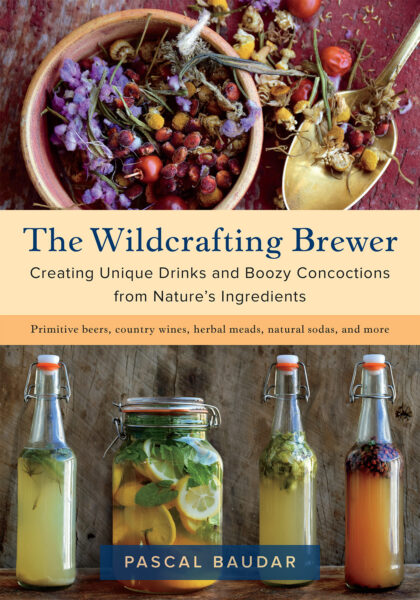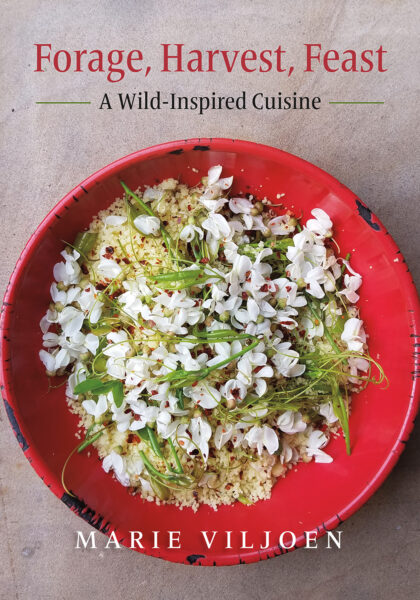The wonderful world of lemons
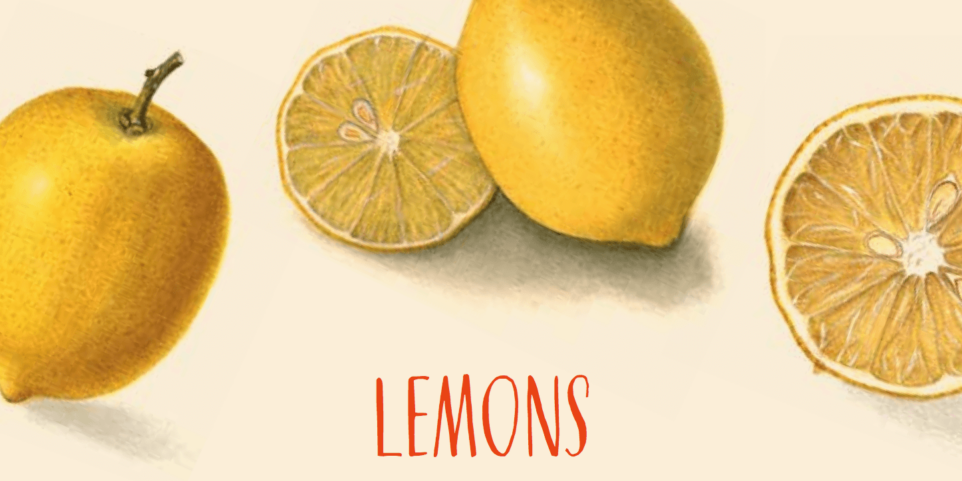
We all need to give lemons some more credit because they are truly one of the most versatile fruits. Think of how many foods and drinks you can incorporate lemons into. If you live somewhere warm and sunny year round, you better get outside and start looking for some lemon trees (we recommend Meyer lemons!).
Keep reading for a quick all-you-need-to-know guide on lemons. And don’t miss the special recipe for “Amazing Meyer Lemon Lemonade” at the end! You also might like Luscious Lemons: Classic Lemon Bar Recipe
The following excerpt is from The Fruit Forager’s Companion by Sara Bir and has been adapted for the web.
Citrus limon
Rutaceae family
Southern US in zones 9–11
How wonderful it is to live in a world where a lemon is never just a lemon! All of the citrus we are familiar with descended from four species: the pomelo, the mandarin, the papeda (a forerunner of limes), and lastly the citron, thick of skin and scant of flesh. Citrons are the ancestors of lemons.
Old songs and sayings about lemons never flatter the fruit. This is perhaps because lemons are not enjoyable straight from the branch, but it’s a very shortsighted point of view. What is a perfectly cooked cod fillet without its final redeeming squirt of lemon juice? What is a bowl of salad greens, olive oil, and salt without the vital kiss of acid?
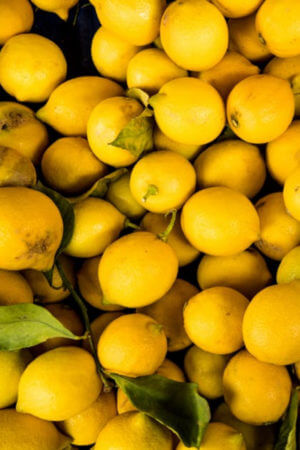
Foraged lemons are fantastic, because (assuming they are free of pesticides) you can use the peels and zest without fear. (Any pesticides applied to citrus are more concentrated in the peels, which is why some recipes calling for a lot of citrus zest specify using organic citrus.) Those who live in places that are sunny year-round will do well to seek out lemon trees, which will flower and fruit sporadically all year, though in climates that are quite warm the spring and fall will see bigger loads of fruit.
Natural mutation, cross-pollination, and human manipulation have led to the lemons we widely buy in stores today: Eurekas, which are slightly elongated with dimpled skins, and Lisbons, which have more prominent nipples and smoother skins. There’s an exciting Variegated Pink Fleshed Eureka, striped green and yellow when ripe and holding pink-tinged flesh inside, though good luck running across one of those.
Happening upon a Meyer lemon tree is much more likely. In the early 2000s Meyers crossed over in public opinion from being something neat to grow to being something neat to eat, and this onetime novelty fruit is now available at mainstream grocery stores. Its name carries cachet in epicurean circles, but its increased presence in recipes and on menus hasn’t dampened its allure to me.
Ruth Reichl, onetime editor of Gourmet, stated in an interview that Meyer lemons are overrated. “I am not a Meyer lemon person . . . I like acid. They’re muted. I hate the fact that everyone loves Meyer lemons.” Now I think of Ruth Reichl every time I see them or buy Meyer lemons, and I buy them every time I see them. Instead of thinking of Meyer lemons as lemons with no spine, I see them as their own specific citrus. They are mild, with an enticing floral character. I just can’t get enough of them.
I tasted my first Meyer lemon not long after moving to California’s wine country in early 2000. I journeyed there with dreams of becoming a wine writer, but instead became a pop music critic, an unpaid yet undeniably cooler hobby I subsidized with a job shelving books at the central branch of the county public library.
An anonymous fellow library employee had a tree in her yard, and she’d bring big paper grocery sacks straining under the weight of the Meyer lemons they held. I brought those sacks home, because they were free, and made their contents into lemonade using an extremely complicated procedure I’d read about in Cook’s Illustrated.
I had no idea the lemons I was mashing up were Meyer lemons; I just thought they were weird but neat. They had a slight herbal smell, and their pretty yellow-orange peels were thinner than what I was accustomed to. They perplexed and delighted me. I took to mixing the resulting fragrant lemonade with Hamm’s to make shandy, something I liked drinking after the long runs I’d take on gravel roads crisscrossing Sonoma’s rolling stands of madrone and eucalyptus trees. I was twenty-three and had very few obligations in life. Everything lay ahead of me, little pockets of promise to hunt like Easter eggs.
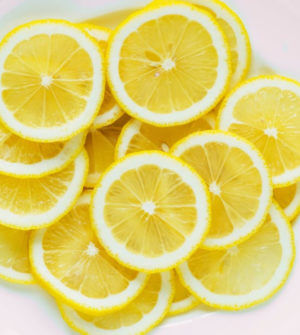
I later quit my library job and eventually left California altogether, ditching the land of free hybrid citrus and hills stretched on the horizon like big, golden sleeping dogs. Now, a kid and a husband and a dozen jobs later, just handling a Meyer lemon triggers endorphins in my brain. I equate their flowery perfume with potential, with freedom, with can after golden can of Hamm’s poured into a sweaty glass half filled with the most exquisite lemonade I’ll ever make. I don’t blame Ruth Reichl for getting peeved with the fuss people make over Meyer lemons, but I’ll never pass up an opportunity to go past-tripping when I spot an overpriced bag of these rare beauties in my Midwest grocery store.
Meyer lemons got their name from Frank Meyer, a US Department of Agriculture employee whose job was to import new plants to the country. Meyer (née Frans Nicholas Meijer) was an émigré from the Netherlands. An official USDA certificate he carried on one of his expeditions stated he was traveling with “the purpose of Aiding in Agricultural Development, especially along the line of Pomology.” Between 1905 and 1918, he took multiple expeditions through Asia to collect plants. A 1908 photo of Meyer shows him in rugged explorer mode, standing with a walking stick against a backdrop of boulders. On the ground to his left are several burlap sacks of plant specimens.
Meyer introduced over twenty-five hundred plants to the United States—not just the Meyer lemon. But his life came to an abrupt end when he fell overboard from a passenger boat in the Yangtze River in 1918 and drowned. The oft-repeated origin of Meyer lemons begins with Meyer’s “discovery” of this fruit in exotic China, but obviously they existed before an employee of the US government came traipsing around, and that’s the part of the story I like to ponder. Some scientists speculate Meyer lemons are a hybrid of a true lemon and a mandarin orange, sweet orange, or bitter orange. Others consider it to be a selected cultivar of the lemon, and refer to it as Citrus limon ‘Meyeri’.
In outdated literature about citrus cultivation, you’ll sometimes see Meyers vilified as a “scourge.” That’s because Meyer lemon trees were a carrier of the citrus tristeza virus, which could spread to other citrus trees—not just Meyers. Happily, the current Meyer lemon variety (Improved Meyer, introduced in 1971) is resistant to the virus.
The trees are compact, more cold hardy than other citrus varieties, and don’t require much pruning—all reasons they are a popular choice for landscaping. The peak of fruit production is late winter through early spring. If you don’t grow one, the next best thing is to live close to someone who does.
For those who don’t reside in Mediterranean-esque climates, growing Meyer lemons indoors in containers is the next best thing (in fact, they are one of the easiest citrus varieties to grow in containers). While your annual crop will be comparatively minuscule, the rewards are a cheerful sight to have inside in the winter—especially if you’re savoring your petite, sunny harvest when there’s still snow on the ground outside.
Harvesting and Storage
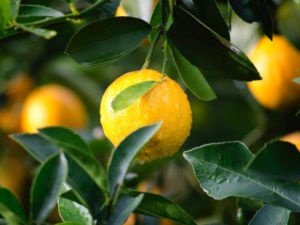 Look for lemons with skin that’s supple, shiny, and yellow. Leave lemons with green skin on the tree to ripen more. Lemons a few days past peak ripeness will taste flat and won’t be as juicy.
Look for lemons with skin that’s supple, shiny, and yellow. Leave lemons with green skin on the tree to ripen more. Lemons a few days past peak ripeness will taste flat and won’t be as juicy.
Every restaurant I’ve worked in had a plastic bin full of lemons in the walk-in, and inevitably one on the bottom would go bad and set off a white mold chain reaction, spoiling the lot. Lesson: Do not store lemons all piled up. Do refrigerate them, which will keep them from getting wrinkly and tired looking. Kept in a sealed plastic bag, they’ll stay pert for a month or so.
Thin-skinned Meyer lemons need slightly more careful handling. I’ve refrigerated them for up to a month, but they are quicker to mold than other citrus. Use them within a week or so to be on the safe side.
Culinary Possibilities
Look in the test kitchen of a big-time food publication, and likely you’ll see a pile of zested lemons kicking around in a crisper drawer. Lemon zest adds that bright citrus flavor without pushing the acid level out of balance. Zest lemons with abandon, adding them to vegetables (brassicas like broccoli and cauliflower love the lift), rubs for lamb or veal, and fruit desserts galore.
Unless you run a restaurant, a single productive lemon tree could provide more lemons than even a sane cook can burn through. Fortunately, our twin crystalline vices, salt and sugar, transform the fruit when applied liberally. Cure whole lemons in salt and eventually you get an insane lemon drop smell, though sometimes it reminds me more of Pledge furniture polish. Preserved lemons last forever and ever and taste like lemon zest crossed with capers. I dice the peels finely and add them to things I’d normally add lemon zest and capers to—a lot, really.
As for sugar, there’s candied lemon peel, which is quite good when you make it yourself (sorry, grocery store citron tubs). Custardy lemon curd freezes well to fill tart shells and swirl into ice cream in the future. And as the old saying goes, you can always make lemonade. If you are then still awash in lemons, consider beauty treatments.
Amazing Meyer Lemon Lemonade
Makes about 5 cups (1.2 L)
Here it is, the lemonade that sold me on Meyers. I read about this technique years ago in Cook’s Illustrated, and as I recall, they’d discovered it in a nineteenth-century cookbook. The details are clouded in the haze of memory—the important thing is the method itself, which yields an intensely flavored, sophisticated lemonade because of the citrus oils released during the pummeling step. Also: Mashing lemons is wonderful for anger management.
If you have many lemons—Meyer or not—you can scale this recipe up. It’s more about the ratio and method than exact measurements.
- 1 pound (455 g) Meyer lemons
- Up to 1 1/2 cups (300 g) granulated sugar, divided
- 4 cups (960 ml) water

If the lemons are not organic, rinse them off and rub them dry. Cut them in half pole to pole, and then slice them crosswise into half-moons between 1/8 and 1/4 inch (3 to 6 mm) thick. Accuracy and looks aren’t important here, but the thinner the slices, the quicker their juice will release.
Dump the lemon slices into a deep, nonreactive stockpot or Dutch oven, and add 1 cup (200 g) sugar. With a potato masher, pound the slices until the sugar begins to dissolve and the lemons give up their juice. You can take a break for a few minutes, let the maceration do its work, and come back to pound some more. In the end, you’ll have pummeled the lemon slices in a syrupy liquid.
Scrape the mixture into a wire-mesh strainer set over a medium bowl. Press with a sturdy wooden spoon to get the lemons to give up as much liquid as possible (it will probably be about a cup). Transfer to a pitcher, and add the water. Taste, and add more sugar, if needed.
Serve chilled over ice. I really like this with a little vodka or moonshine, but obviously virgin lemonade is exquisite, too. For a shandy, combine about 1 part lemonade to 1 part lager or ale (make sure it’s not too hoppy, though).
Recommended Reads
Recent Articles
Garlic mustard: while known as “invasive,” this plant can be consumed in its entirety and has great nutritional value. Plus, the garlic-flavor is a perfect addition to any recipe that calls for mustard! The following are excerpts from Beyond the War on Invasive Species by Tao Orion and The Wild Wisdom of Weeds by Katrina…
Read MoreOh, honeysuckle…how we love thee. If only there was a way to capture the sweet essence of this plant so we could enjoy it more than just in passing. Luckily, foraging and some preparation can help make that happen! Here’s a springtime recipe that tastes exactly like honeysuckle smells. The following excerpt is from Forage,…
Read MoreIntroducing…your new favorite brunch dish! This whole broccoli frittata is packed with fresh, wildcrafted flavors that are bound to help you start your day off on the right foot. The following is an excerpt from The Forager Chef’s Book of Flora by Alan Bergo. It has been adapted for the web. RECIPE: Whole Broccoli Frittata…
Read MoreWondering where to forage for greens this spring? Look no further than hedges, which serve as natural havens for wild greens and herbs! The following is an excerpt from Hedgelands by Christopher Hart. It has been adapted for the web. Food from Hedges: Salads and Greens Let’s start by looking at all the wild foods…
Read MoreThere’s a whole new world out there when it comes to koji. It doesn’t matter if you’re making bread, cheese, or ice cream, koji helps you pump up the flavor! Growing Koji in Your Own Kitchen Koji, the microbe behind the delicious, umami flavors of soy sauce, miso, fermented bean sauce, and so many of…
Read More


